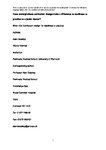Does undergraduate curriculum design make a difference to readiness to practice as a junior doctor?
| dc.contributor.author | Bleakley, A | |
| dc.contributor.author | Brennan, N | |
| dc.date.accessioned | 2018-03-13T12:30:39Z | |
| dc.date.available | 2018-03-13T12:30:39Z | |
| dc.date.issued | 2011-05-24 | |
| dc.identifier.issn | 0142-159X | |
| dc.identifier.issn | 1466-187X | |
| dc.identifier.uri | http://hdl.handle.net/10026.1/11082 | |
| dc.description.abstract |
Background: Undergraduate medicine curricula can be designed to enable smoother transition to work as a junior doctor. Evaluations should improve curriculum design. Aim: To compare a graduate cohort from one medical school with a cohort from other medical schools in the same Foundation Year 1 (FY1) programme in terms of retrospective perceptions of readiness for practice. Method: A Likert-scale questionnaire measured self-perception of readiness to practice, including general capabilities and specific clinical skills. Results: Response rate was 74% (n=146). The Peninsula Medical School cohort reported readiness for practice at a significantly higher level than the comparison cohort in 14 out of 58 items (24%), particularly for ‘coping with uncertainty’. In only one item (2%) does the comparison cohort report at a significantly higher level. Conclusions: Significant differences between cohorts may be explained by undergraduate curriculum design, where the opportunity for early, structured work-based, experiential learning as students, with patient contact at the core of the experience, may promote smoother transition to work as a junior doctor. Evaluation informs continuous quality improvement of the curriculum. | |
| dc.format.extent | 459-467 | |
| dc.format.medium | ||
| dc.language | English | |
| dc.language.iso | English | |
| dc.publisher | Taylor & Francis | |
| dc.subject | Attitude of Health Personnel | |
| dc.subject | Clinical Competence | |
| dc.subject | Cohort Studies | |
| dc.subject | Curriculum | |
| dc.subject | Education, Medical, Undergraduate | |
| dc.subject | Humans | |
| dc.subject | Schools, Medical | |
| dc.subject | Students, Medical | |
| dc.subject | Surveys and Questionnaires | |
| dc.subject | United Kingdom | |
| dc.title | Does undergraduate curriculum design make a difference to readiness to practice as a junior doctor? | |
| dc.type | journal-article | |
| dc.type | Article | |
| plymouth.author-url | https://www.ncbi.nlm.nih.gov/pubmed/21609175 | |
| plymouth.edition | 2011 | |
| plymouth.issue | 6 | |
| plymouth.volume | 33 | |
| plymouth.publication-status | Published | |
| plymouth.journal | Medical Teacher | |
| dc.identifier.doi | 10.3109/0142159X.2010.540267 | |
| plymouth.organisational-group | /Plymouth | |
| plymouth.organisational-group | /Plymouth/Faculty of Health | |
| plymouth.organisational-group | /Plymouth/Faculty of Health/Peninsula Medical School | |
| plymouth.organisational-group | /Plymouth/REF 2021 Researchers by UoA | |
| plymouth.organisational-group | /Plymouth/REF 2021 Researchers by UoA/UoA23 Education | |
| plymouth.organisational-group | /Plymouth/Users by role | |
| plymouth.organisational-group | /Plymouth/Users by role/Academics | |
| dc.publisher.place | UK | |
| dcterms.dateAccepted | 2011-05-01 | |
| dc.identifier.eissn | 1466-187X | |
| dc.rights.embargoperiod | Not known | |
| rioxxterms.versionofrecord | 10.3109/0142159X.2010.540267 | |
| rioxxterms.licenseref.uri | http://www.rioxx.net/licenses/all-rights-reserved | |
| rioxxterms.licenseref.startdate | 2011-05-24 | |
| rioxxterms.type | Journal Article/Review |


